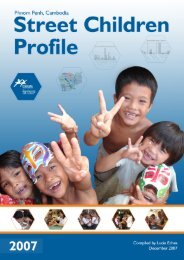Download - Friends International
Download - Friends International
Download - Friends International
Create successful ePaper yourself
Turn your PDF publications into a flip-book with our unique Google optimized e-Paper software.
Reasons for Living and/or Working on the Streets – Phnom Penh 2009<br />
600<br />
500<br />
400<br />
300<br />
587<br />
200<br />
100<br />
208<br />
0<br />
193 190<br />
129<br />
48<br />
16 7 1<br />
PovertyUnemployment<br />
Migration<br />
DrugUse<br />
<strong>Friends</strong><br />
FamilyIssues<br />
Orphan<br />
EnjoyStreetLife<br />
DivorceOrSeparatedParents<br />
ChildTrafficking<br />
NoInformation<br />
Poverty appears to be the main reason for why children/youth end up living or working<br />
on the streets – both in the location specific context of Phnom Penh, by comparing<br />
to last years results, and reflecting the general results of the CSCN questionnaire<br />
survey. Out of the total questionnaires in Phnom Penh, more than half of the children/<br />
youth (56.2 percent) describe their situation as a consequence of poverty. Additionally,<br />
as poverty encourages the movement of people, a correlation which is identified in<br />
the graphs, the second most answered reason for working or living on the streets is<br />
migration (19.9 percent). According to the CSCN members in Phnom Penh, poverty as<br />
a consequence of unemployment has increased as several factories (particularly in the<br />
garment sector) have closed down – both due to the international financial crisis and<br />
because of competitive disadvantages compared to other countries in the region.<br />
86<br />
The abuse of drugs and other substances is the third most common reason for ending up<br />
on the streets at 18.5 percent – a trend that has more than tripled from the CSCN SCP<br />
2008. As revealed in analytical Frame I, a recent survey conducted by MS concludes<br />
that particularly the increased usage of ATS such as Yama has added to this trend.<br />
Of the total SLC population in Phnom Penh, the MS survey moreover finds that 41.8<br />
percent are using substances.<br />
CSCN<br />
CSCN Street Children Profile 2009<br />
37






